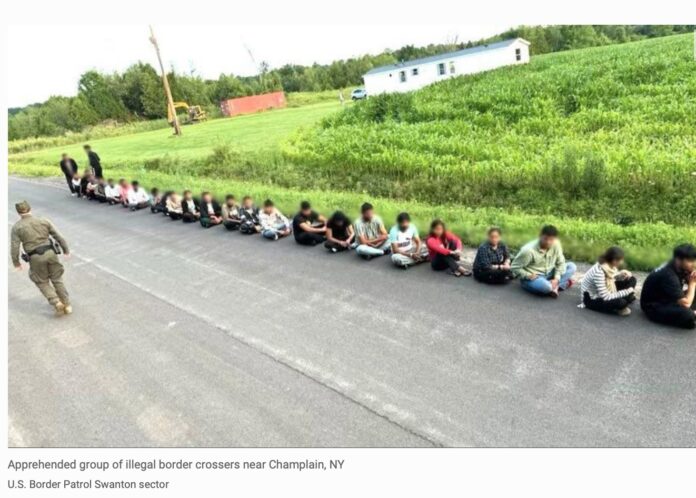The Terrorist Screening Dataset is a watchlist that contains the names of over a million suspects who pose a threat to the United States. It was conceived in the aftermath of the September 11, 2001 attacks and is maintained by the Federal Bureau of Investigation for the use of multiple law enforcement agencies, such as Customs and Border Protection.
When most people think of how a terrorist might attempt to penetrate the U.S. interior, their thoughts understandably gravitate toward the southern border. But in 2023, 85 percent of all land-based encounters with individuals on the terrorist watchlist occurred along the Lower 48’s northern border with Canada, according to an analysis by the Wilson Center.
The United States-Mexico border gets most of the attention, and that makes sense, considering how porous it has been over the years, functioning more like an international highway for people and drugs than a boundary between nations. There is ample reason to take seriously growing security concerns, not least because our border with Canada is the longest land barrier in the world, spanning more than 5,500 miles of mostly rough and remote terrain, making it increasingly attractive to traffickers and terrorist threats.
Although it has changed, the initial demarcation with our northern neighbors has its roots in the American Revolution. The same treaty that ended the war with Great Britain also created the boundary between the nascent United States and the British Empire in North America. Today, it encompasses more than 8,000 monuments, seven states, an equal number of Canadian provinces and one territory. The part of the northern border that separates Alaska from Canada consists of a stretch of land greater than 1,500 miles long. For comparison, the southern border with Mexico is only 400 miles longer. And yet, the Alaska-Canada border receives just a fraction of the resources and attention that its counterpart does.
It’s true that comparatively more drugs like fentanyl enter America through the south than the north. However, that does not change the fact that Alaskan boroughs have become hotspots for drug activity.
Through what it coined the “Disproportionality Index” (DI), the Manhattan Institute devised a system that allows for a comparison between a county’s proportion of large fentanyl seizures against its proportion of the national population for 2023-2024. A score of 1.0 means that the number of seizures is proportionate to the local population, while a score lower than 1.0 indicates fewer seizures than expected, and a score greater than 1.0 indicates more seizures than expected. Of the three counties or collections of counties along the northern border with an average DI greater than 1 were Juneau and Ketchikan, which the institute concluded is “suggestive of Alaska markets possibly being supplied from Canada.”
Notably, 2023 was the year that Alaska witnessed its highest number of opioid overdose deaths, the majority of which were attributed to fentanyl. That marked a nearly 40 percent increase over the previous year and the largest percent increase of any state during the same period. The staggering death toll has spurred various campaigns to raise awareness, such as Sen. Dan Sullivan’s “One Pill Can Kill” initiative.
“A single deadly dose of fentanyl fits on the tip of a pencil,” Sullivan says in an educational video released as part of the campaign. “Seven out of every ten pills seized by the DEA contain a lethal dose of fentanyl.”
On Wednesday, the Trump administration signed the HALT Fentanyl Act, which reclassified the drug as a Schedule 1 substance, placing it in the same category as the government’s most restricted substances. That’s good news for America, and great news for Alaska, which has been fighting an uphill battle out of the national limelight against the drug.
The legislation will also enable law enforcement to go after drug traffickers by shutting legal loopholes that had previously provided them with a measure of protection. In a statement to Must Read Alaska, a spokesperson for the Federal Bureau of Investigation said the agency is focused on identifying the source of the problem.
“The FBI remains focused on disrupting and dismantling transnational organized crime groups whose actions violate the laws of the United States and bring harm to U.S. citizens, wherever and however these crimes may occur,” said Chloe Martin, the public affairs specialist for the FBI in Anchorage. “We urge anyone who witnesses illicit drug trafficking or human trafficking activity in Alaska to contact the FBI.”
You may provide an anonymous tip to the FBI Anchorage Field Office at 907-276-4441, 1-800-CALL-FBI, or online at tips.fbi.gov.

Wow! Makes sense though: while our country’s attention is focused on illegals from our Southern border, state sponsors of terror could easily send terrorists in from the north! Gee: it almost sounds like joe burden’s ‘open border’ policy might have played right into the hands of our nation’s worst enemies? Could it BE?
Duh, Canucks facilitated the invasion as well. Our liberal neighbors to the north, are not our friends.
There are numerous reports of many military age men running across the northern boarder en mass. You can go on line and see videos taken by private citizens. This appears to be a very real problem.
Awareness is good, action to stop the problem is better. A nation wide hot line phone number and an informant rewards $ program would yield faster/timely results.
The number of agents is low, and they have a daunting task, they need the public’s help in identifying drug dealers/users. This real time activities intel will yield more arrest, seizures and apprehensions. Impacting the drug trade/trafficking in the USA.
Addiction is a terrible thing. It claims lives, destroys families. The cash found in all of these cases could be applied to the national debt. Chipping away at the national debt is critical for future generations.